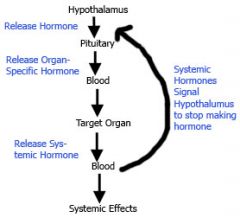![]()
![]()
![]()
Use LEFT and RIGHT arrow keys to navigate between flashcards;
Use UP and DOWN arrow keys to flip the card;
H to show hint;
A reads text to speech;
30 Cards in this Set
- Front
- Back
|
Name two body systems that help maintain body balance (homeostasis)
|
Nervous and endocrine systems
|
|
|
What are two similarities between the nervous and endocrine systems?
|
1) both systems constantly send instructions to the rest of the body
2) both use chemicals to transmit their messages |
|
|
What sort of tissues are usually affected by the nervous system?
|
mostly affects muscle and glandular tissue
|
|
|
What tissues are affected by the endocrine system?
|
affects virtually all cells in the body
|
|
|
The effects of the endocrine system are (short/long) acting.
|
effects are long acting
|
|
|
Why are the effects of the endocrine system slower than the nervous system?
|
The chemicals produced by the nervous system only have to cross the synaptic space while hormones must travel long distances through the bloodstream.
|
|
|
Define hormones.
|
chemical messages produced by the endocrine system
|
|
|
Give the location of the hypothalamus and its hormone function.
|
brain, receives info about the state of the body & responds. Controls pituitary.
|
|
|
Name 5 body states controlled by the hypothalamus.
|
1) BP
2) temp 3) weight 4) fluid levels 5) electrolytes |
|
|
What kind of hormone(s) does the hypothalamus produce?
|
peptide hormones
|
|
|
Give the location of the pituitary and the type(s) of hormones produced.
|
brain, peptide and steroid
|
|
|
Give the location of the pineal gland, the hormone produced, and its function.
|
brain, melatonin, regulates sleep cycle
|
|
|
Where is the thyroid located?
|
located in the neck
|
|
|
Name two substances the thyroid produces.
|
thyroxine (aka tetraiodothyronine)
calcitonin |
|
|
What are the function of the thyroid hormones?
|
thyroxine- controls metabolism
calcitonin- regulates calcium levels in blood by storing in in bone |
|
|
Calcium is necessary for muscle __________.
|
necessary for muscle contraction
|
|
|
Where is the parathyroid and what is its function?
|
located on the thyroid, regulates calcium levels by leaching it from bones
|
|
|
Where is the pancreas and what is its function?
|
located to the right of the stomach, controls metabolism, specifically glucose levels
|
|
|
What are the two hormones produced by the pancreas and what are their functions?
|
insulin- dec glucose levels
glucagon- inc glucose levels |
|
|
Name the location and regions of the adrenal glands.
|
located next to kidneys, consist of the cortex and the medulla
|
|
|
The medulla of the adrenal gland produces ______________ and is a (steriod/peptide) hormone.
|
produces catecholamines which are peptide hormones
|
|
|
The cortex of the adrenal gland produces ______________, ________, and _____ __________ and is a (steriod/peptide) hormone.
|
produces mineralcortocoids, glucocorticoids and sex hormones, which are steroid hormones
|
|
|
Name the two types of gonads and the hormones they produce
|
ovaries (abdominal) produce steroid hormones estrogen and progesterone
testes (external) produce testosterone |
|
|
Name 8 endrocrine glands.
|
1) hypothalamus
2) pituitary 3) pineal gland 4) thyroid 5) parathyroid 6) pancreas 7) adrenal glands 8) gonads |
|
|
Name three ways massage relieves pain.
|
1) increasing endorphins, encephalin and other pain-reducing chemicals
2)inhibits pain by interfering with pain information 3) relieves pain from hypersensitive trigger points and referred pain (presumably by decreasing ischemia) |
|
|
What effects can massage have on the nervous system?
|
1) can either stimulate or soothe this system, depending on stroke and pressure
2) stimulates the parasympathetic NS, promoting relaxation decreasing insomnia |
|
|
What are two effects of massage on muscle tissues?
|
1) mechanically stretches and broadens tissue
2) certain strokes increase muscle spindle activity, toning weak muscles |
|
|
Describe two types of hormone molecules.
|
1) peptide- derived from protein
2) steroid- derived from fats |
|
|
Describe a systemic negative feedback loop
|
Negative feedback acts like a thermostat to turn off a process when the level of the finished product reaches the proper concentration in the bloodstream
|
|
|
Draw a negative feedback loop involving the hypothalamus
|

see image
|

